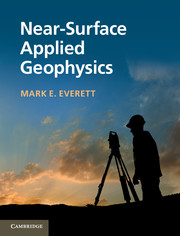Book contents
- Frontmatter
- Contents
- Preface
- Acknowledgments
- 1 Introduction
- 2 Data analysis
- 3 Magnetics
- 4 Electrical resistivity method
- 5 Induced polarization and self-potential
- 6 Seismic reflection and refraction
- 7 Seismic surface-wave analysis
- 8 Electromagnetic induction
- 9 Ground-penetrating radar
- 10 Emerging techniques
- 11 Linear inversion
- 12 Non-linear inversion: local methods
- 13 Non-linear inversion: global methods
- Appendix A Shannon sampling theorem
- Appendix B Solution of Laplace’s equation in spherical coordinates
- Appendix C The linear τ–p transformation of seismic data
- Appendix D Horizontal loop over a conducting halfspace
- Appendix E Radar TE waveguide mode equations
- References
- Index
- Plate section
7 - Seismic surface-wave analysis
Published online by Cambridge University Press: 05 April 2013
- Frontmatter
- Contents
- Preface
- Acknowledgments
- 1 Introduction
- 2 Data analysis
- 3 Magnetics
- 4 Electrical resistivity method
- 5 Induced polarization and self-potential
- 6 Seismic reflection and refraction
- 7 Seismic surface-wave analysis
- 8 Electromagnetic induction
- 9 Ground-penetrating radar
- 10 Emerging techniques
- 11 Linear inversion
- 12 Non-linear inversion: local methods
- 13 Non-linear inversion: global methods
- Appendix A Shannon sampling theorem
- Appendix B Solution of Laplace’s equation in spherical coordinates
- Appendix C The linear τ–p transformation of seismic data
- Appendix D Horizontal loop over a conducting halfspace
- Appendix E Radar TE waveguide mode equations
- References
- Index
- Plate section
Summary
Surface-wave-based methods involving active or passive sources are used in investigations spanning a wide range of scales from ultrasonic non-destructive evaluation of civil infrastructure to global seismic imaging of the Earth’s mantle. Near-surface geophysical applications with active sources, probing to depths ~ 30 m, are experiencing steady growth (Socco et al., 2010). For the most part, the key information is embedded in high-amplitude, low-frequency Rayleigh waves, i.e. the ground roll that is normally regarded as a source of noise in seismic body wave reflection and refraction studies. Typically, surface or interface waves of various types (e.g. Rayleigh, Love, Scholte, Lamb, and Stoneley waves) are guided and highly dispersive. Recognition of these properties drove the development in the 1980s of the spectral analysis of surface wave (SASW) method (Nazarian and Stokoe, 1986) and, later, the multichannel analysis of surface wave (MASW) method (Park et al., 1999). In these and other related techniques, apparent Rayleigh phase velocity versus frequency curves are first constructed, and then inverted to obtain shear-wave depth profiles. The resulting estimates of shear-wave speed in the shallow subsurface can be interpreted in terms of physical properties such as stiffness, liquefaction potential, and moisture content. These properties are of great interest to geotechnical and construction engineers, soil scientists, and others. In addition, the magnitude of ground shaking in response to a nearby earthquake is highly dependent on the subsurface shear-velocity structure.
Rayleigh waves
Consider a mechanical disturbance within an infinite homogeneous elastic medium. Both compressional (P-) and shear (S-) body waves are generated, as described in the previous chapter. Suppose now the elastic medium occupies only the lower halfspace, such that a free surface is present. In this case there exists also a Rayleigh wave (R-wave) solution to the elastic wave equations (Richart et al., 1970). If the medium is heterogeneous, with spatially varying elastic moduli, the R-wave packet is dispersive. The wave packet can be decomposed by Fourier analysis into its individual frequency components. Each frequency component of the wave packet travels at its own characteristic phase velocity. The shape of the phase velocity versus frequency curve is sometimes called the dispersion characteristic. Note that an R-wave traveling in a homogeneous elastic medium is not dispersive.
- Type
- Chapter
- Information
- Near-Surface Applied Geophysics , pp. 182 - 199Publisher: Cambridge University PressPrint publication year: 2013



